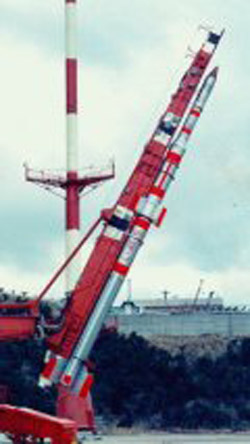L series (Japanese rockets)

L-4S #5 on its launch pad.
The Lambda serie, or L series, of Japanese rockets was a family of launch vehicles developed and operated by the Institute of Space and Astronautical Science (ISAS), a division of the Japan Aerospace Exploration Agency (JAXA). The rockets in this family were effectively scaled-up versions of the solid-propellant Kappa sounding rockets. The Lambda series was developed in the late 1960s and 1970s and was used for a variety of missions, including the launch of scientific satellites and the study of the upper atmosphere.
The first launch of a Lambda rocket took place in February 1970, and the series was in active service until the last launch in 1995. The Lambda series consisted of four main variants, each of which was designated by a letter: Lambda-4S, Lambda-4SII, Lambda-4SIII, and Lambda-4S-IV.
The Lambda-4S was the first variant of the Lambda series and was primarily used for the launch of scientific satellites. It had a maximum payload capacity of 150 kg and was capable of placing a satellite into a low Earth orbit (LEO). The fifth launch of an L-4S placed Japan's first artificial satellite, Ohsumi, in orbit on 11 February 1970. The Lambda-4SII was an upgraded version of the Lambda-4S, had a maximum payload capacity of 200 kilograms, and was capable of placing a satellite into a higher altitude LEO.
The Lambda-4SIII was the third variant and was primarily used for upper atmospheric research. It had a maximum payload capacity of 100 kilograms and was capable of reaching an altitude of 800 kilometers. The Lambda-4S-IV was the final variant of the Lambda series and was primarily used for the launch of scientific satellites. It had a maximum payload capacity of 150 kilograms and was capable of placing a satellite into a LEO.
The Lambda series was an important development in the history of Japanese space exploration. It demonstrated Japan's capability to develop and operate its own launch vehicles and played a significant role in the country's space program.
| Data for the L-4S #5 that launched Japan's first satellite | ||||||
|---|---|---|---|---|---|---|
| 1st st. | SOB | 2nd st. | 3rd st. | 4th st. | ||
| total length | m | 16.522 | 5.772 | 8.141 | 4.067 | 1.104 |
| weight (ig.) | kg | 9399.0 | 1005.0 | 3417.6 | 943.1 | 111.0 |
| weight (b.o.) | kg | 4507.0 | 381.0 | 1562.5 | 394.9 | 23.05 |
| propellant weight | kg | 3887.0 | 624.0 | 1845.0 | 547.5 | 87.95 |
| mass ratio |
|
1.982 | 2.187 | 2.388 | 4.816 | |
| specific impulse | sec | 215.0 | 220.0 | 242.9 | 249.3 | 254.0 |
| center of gravity (ig.) | % | 59.0 | 52.9 | 63.0 | 61.8 | 64.5 |
| center of gravity (b.o.) | % | 43.2 | 54.3 | 49.6 | 44.8 | 55.7 |
| Ix (ig.) | kg.m.sec2 | 79.89 | 25.48 | 3.52 | 0.259 | |
| Iy (b.o.) | kg.m.sec2 | 16192 | 1259.4 | 99.71 | 0.436 | |
| net payload | kg | 6.6 | 36.3 | 7.62 | ||
| gross payload | kg | 7.6 | 96.1 | 8.42 | ||
| maximum diameter | mm | 767.0 | 310.0 | 767.0 | 548.0 | 483.0 |


